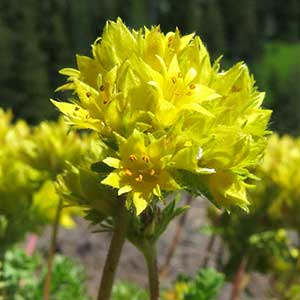Ivesia gordonii
Ivesia sericoleuca
alpine ivesia, alpine mousetail, Gordon's ivesia
Plumas ivesia, Plumas mousetail
prostrate to erect, (0.2–)0.5–4 dm.
decumbent to ascending, 1.5–4.5 dm.
tightly to loosely cylindric, (1–)3–20(–25) cm; sheathing base ± glandular abaxially, otherwise glabrous;
petiole 0.5–8 cm, hairs 0.2–0.5 mm;
leaflets (6–)10–25 per side, (1–)2–13(–18) mm, glabrous or ± hirsute or villous, glandular-puberulent or -pubescent, lobes (2–)4–8(–15), linear or narrowly oblanceolate to obovate, apex rarely setose.
10–20(–30) cm; sheathing base densely strigose abaxially;
stipules absent;
petiole 2–6(–10) cm, hairs abundant, usually spreading, 1–4 mm;
leaflets 20–35 per side, loosely overlapping, 3–15 mm, lobes 0–4, oblanceolate to elliptic, hairs abundant, spreading to ascending, (0.5–)1–3(–4) mm.
1(–2), not paired.
3–8(–10).
5–50(–70)-flowered, 1–8(–11) cm diam.;
glomerules 1–several.
20–120-flowered, (2–)4–14 cm diam., flowers mostly arranged in several to many tight glomerules of 5–10 flowers.
1–3(–5) mm.
1–3(–12) mm.
5–12 mm diam.;
epicalyx bractlets linear to narrowly elliptic, (0.5–)1–3.5(–4) mm;
hypanthium turbinate to campanulate, (1.5–)2–4(–4.5) × 2–4(–5) mm;
sepals (2–)2.5–5(–6) mm, obtuse to ± acute;
petals yellow, narrowly oblanceolate to narrowly spatulate, (1–)1.5–3 mm;
stamens 5, filaments 1.3–2.5 mm, anthers yellow, sometimes red-margined, 0.5–1 mm;
carpels (1–)2–4(–6), styles 2.5–4.5(–6) mm.
10–15 mm diam.;
epicalyx bractlets narrowly lanceolate to narrowly elliptic, (1.5–)2–2.5(–3) mm;
hypanthium campanulate to shallowly turbinate, 1.5–3 × 2.5–4.5(–5) mm, often nearly as deep as wide;
sepals sometimes purple-suffused, 3–5.5 mm, acute to acuminate;
petals white, broadly spatulate to broadly obovate or obcordate, 4–7 mm;
stamens 20, filaments filiform, 1.5–3 mm, anthers white to cream, 0.5–0.7 mm;
carpels 2–7, styles 2.5–4 mm.
grayish brown to mottled brown, ± 2 mm.
brown, 2–3 mm.
= 28.
Ivesia gordonii
Ivesia sericoleuca
Varieties 4 (4 in the flora).
Ivesia gordonii is the most widespread species of the genus, occurring from Washington to Montana, south to central California and Colorado. The species can be distinguished from other members of sect. Ivesia by the relatively deep hypanthium, which is about as deep as wide. Four varieties are provisionally recognized here (B. Ertter and J. L. Reveal 2007), with the likelihood that future work may indicate additional and/or alternate circumscriptions. Populations that are difficult to assign to a variety can be found where the recognizable taxonomic units come together, for example, in northeastern Utah and western Wyoming, involving var. gordonii and var. wasatchensis, and in California and central Idaho where var. alpicola and var. ursinorum tend to merge.
(Discussion copyrighted by Flora of North America; reprinted with permission.)
Of conservation concern.
Ivesia sericoleuca is known from valleys and flats in the northern Sierra Nevada. Many historic collections were identified and distributed as I. unguiculata, and circumscriptions prior to 1962 include I. aperta (hence reports from Nevada).
Hairs are usually dense in plants of Ivesia sericoleuca, such that the leaves, and occasionally the stems and branches, are silvery gray, especially in Sierra Valley and the Feather River drainage. Plants in the Truckee River drainage tend to be less hairy with redder stems, less glomerate inflorescences, shallower hypanthia, and more conspicuous glandularity.
As mentioned by J. T. Howell (1962), the chromosome count given for Ivesia sericoleuca by P. A. Munz (1959) most likely was based on a collection of I. aperta var. aperta. The chromosome count given here is instead based on Kruckeberg 3665, originally distributed as I. pickeringii.
(Discussion copyrighted by Flora of North America; reprinted with permission.)
1. Leaflets 7–13(–18) mm, glabrous or sparsely hirsute or villous marginally; stems (1–)1.5–4 dm; inflorescences usually branched, 2–8(–11) cm diam., glomerules (1–)2–6(–10), ± capitate. | var. wasatchensis |
1. Leaflets (1–)2–7(–9) mm, hairy or ± glabrous except marginally ciliate; stems (0.2–)0.5–2.5 dm; inflorescences simple or branched, 1–3(–5) cm diam., glomerules 1(–3), ± capitate to loosely congested | → 2 |
2. Stems usually prostrate to ascending, rarely nearly erect, usually dark reddish, minutely glandular or glandular-puberulent to -pubescent; leaves to 0.8 cm diam.; anthers usually red-margined. | var. ursinorum |
2. Stems usually ascending to erect, sometimes decumbent, usually greenish, rarely reddish, hirsute to villous, glandular-puberulent to -pubescent; leaves to 1.5 cm diam.; anthers rarely red-margined | → 3 |
3. Stems usually hirsute to villous, sometimes densely so, glandular-pubescent or eglandular; basal leaves (3–)5–10(–15) cm; flowers 7–12 mm diam.; e Idaho and w Montana to Utah, Wyoming, and w Colorado. | var. gordonii |
3. Stems not or sparsely hirsute to villous, glandular-puberulent or -pubescent; basal leaves 2–8(–10) cm; flowers 5–9 mm diam.; s Washington to California and e to w Montana. | var. alpicola |


